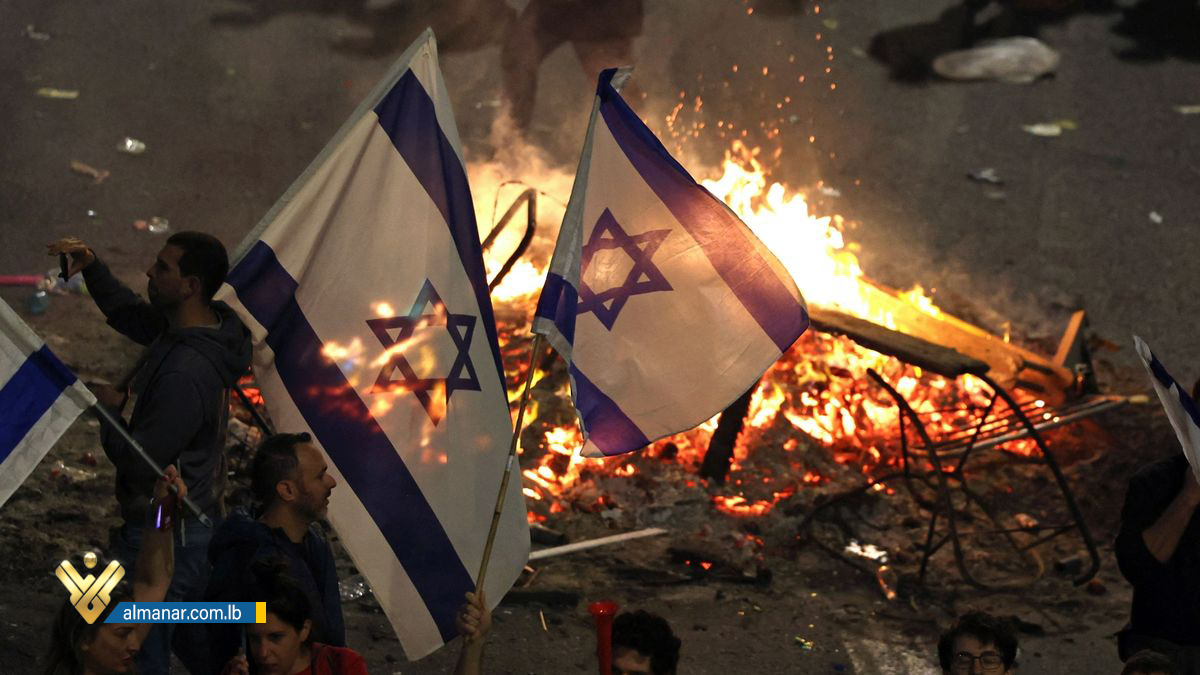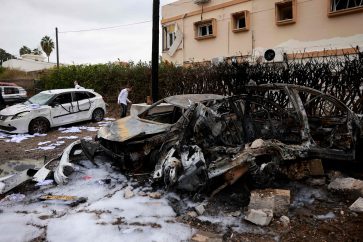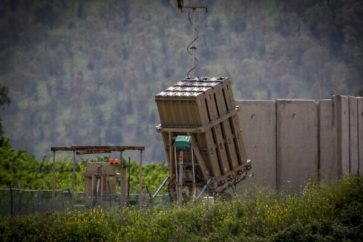Yahya Dbouk*
Translated by Areej Fatima Al-Husseini
On the 75th anniversary of its ill-fated establishment, the occupation regime is not at its best. Where, in addition to the mounting risks in its strategic surroundings, there is a potentially more imminent menace encircling it from within, shaking it and bringing it even closer to the edge of a “brothers’ war“ whose nightmare hangs over the Israeli elites. Indeed, the two parties to the conflict may eventually reach a temporary “conflict freeze” that will save the entity from a new political and public conflict, similar to the one that accompanied Yoav Gallant’s dismissal. Yet, the aforementioned will not signal the end of the crisis; rather, it will merely be postponed until its rebirth is more forceful and thorough. Perhaps what reinforces such forecasts is that the religious people who are leading the “revolution” today will become a vast majority within a few decades, implying greater effectiveness and wider influence.
“Israel” fails to leave the scene of its months-long turmoil, as solutions falter and the advantages of temporary settlements fade. This is added to deferring hard dues exacerbates and deepens the conflict.
On its 75th year, Israel is no longer able to manage the conflicts of its social components, or so-called tribes, after previously controlling them through “understandings” that combined an emphasis on common denominators with the use of security threats to promote “Jewish cohesion,” in what represents a recipe that has already shown relative success.
Tens of thousands of Israelis joined protests against Prime Minister Benjamin Netanyahu’s plans to tighten controls on the Supreme Court, ahead of Israel’s Independence Day marking 75 years since the establishment of the Jewish state https://t.co/t3wjOOoawx pic.twitter.com/VcjiIaVDOB
— Reuters (@Reuters) April 23, 2023
However, these disputes were destined to erupt within two or three decades, as the religious “Haredi” component, as well as the national religious component, grew in number, potency, influence, and power. This will compel them to breach such understandings and choose their ideology over other Jews.
During the previous government, led by Yair Lapid, which brought together all of Benjamin Netanyahu’s opponents, the latter sensed an impending threat to him. The threat was to imprison Netanyahu and halt his political career on corruption and bribery charges. On the other hand, the Haredim found themselves without funding for their institutions or social gifts, with the possibility of being forced to enlist in the Israeli army, as well as the adoption of laws and procedures that revoked some of their status and exclusivity.
The previous administration reminded the fascist extreme right, or “religious Zionists,” that settlements on the so-called “Jewish land in the West Bank” are still viable and have not been fully eliminated from the lexicon of certain groups of Israelis. It also cautioned them that their ambition to Judaize and Talmudize the ‘state’ at the cost of liberals and traditional Jews would not be readily realized.
This combination of threats and dangers compelled those targeted to collaborate, allowing Netanyahu to evade prosecution for his crimes. Such combination also empowered the religious groups, of all types, to enforce their will through laws and legislation that are not susceptible to veto or rejection by the judiciary, which retains power and rejects any attempt to favor one Jewish community over another.
As a result, interests have been focused on eliminating the Supreme Court’s authority to nominate justices and restricting the latter’s capacity to evaluate laws, which is a topic of discord. However, in a “normal” state, such a dispute would not have resulted in the division that Israel is experiencing nowadays. Thus, the current scenario foreshadows civil war, with predecessors that can only be explained by the presence of significant contrasts in visions, aspirations, and ideologies.
After two or three decades, the religious Jews will become the numerical majority, bolstering their position and ability to influence and fight political battles.
As a result, it is evident that the heart of the battle is to prevent or offer an opportunity for Jewish social components to impose their will on other Jewish groups. It is worth noting that proponents of change today seek to monopolize power and implement Talmudic governance by breaching the “defensive wall” represented by the judiciary. Whereas, the opposing camp refuses to harm the judiciary and demands that its powers remain unchanged to prevent any change in the social contract in place for the past seven decades.
The various religious “Haredi” parties are in the first camp, with religious Zionists (the national religious current) on their side, as well as Netanyahu’s right-wing and liberal Likud party.
The second camp is comprised of liberals from multiple parties and movements (right, left, centrist, and even traditional, including an important segment of the “Likud” base). It also includes the majority of Israeli women and youth, as well as homosexuals, who have become prominent number among Jewish organizations. In addition to economists, sociologists, industrialists, diplomats, and others with economic, social, and political contacts overseas.
The division reached the social, economic, political, and diplomatic sectors, as well as military and security institutions. The reservists – the most significant, effective, and influential component in the Israeli army – are at risk of disintegration as the number of individuals refusing to serve has grown, as well as reservists in the Air Force, intelligence, and the Mossad.
On the economic front, the split manifests into warnings of a “gloomy future” for ‘Israel’ as a result of capital flight, evacuation of institutions and corporations, and investor withdrawal. Hence, the protest wave grew to the point where Netanyahu could no longer contain it, especially after he decided to fire his security minister, Yoav Galant (of the Likud), to teach the “Likudists” a lesson. This decision, however, had disastrous ramifications, compelling him to suspend the “judicial overhaul” plan rather than cancel it.
This suspension prompted a decrease in demonstrations, but it wasn’t sufficient to stop them. Rather, opponents are waiting for Netanyahu at the “junction” to re-occupy the squares, while the future coalition is not entirely clear, despite the approaching deadline for postponing the overhaul, which is set for May 1st. Will the coalition then return to the “reform” path, attracting larger and broader protests? Or retreat without admitting failure? Also, what will the opposition’s stance be in both cases? Will they be content with Netanyahu’s retreat, or will they demand more?
Whatever occurs, it will not end the divide, which has deepened as a result of the current crisis. Accordingly, if the religious are unable to dismantle the internal equations and excessive social contracts that exist among Jews, ‘Israel’ will be at a later date, in the near future, with the renewal of the coup attempt, when the numerical status of these people has been further strengthened.
In 2022, religious groups in ‘Israel’ reached 36% of Jews, as opposed to a Jewish majority comprised of secular and non-religious or semi-religious traditionalists. However, this minority, which now controls the government coalition, is likely to grow in number, eventually outnumbering secularists and others. This indicates that within two or three decades, the religious will become the numerical majority, strengthening their position and power to influence and wage political wars.
Therefore, ‘Israel’ is on the verge of further division and maybe civil war, unless decision-makers take action to delay the eruption and let the conflicts be managed for a longer period, especially because agreement on a key consensus is not feasible. Further, if the “brothers’ war” isn’t already bloody, it will be shortly, unless solutions, that are still too vague to discuss, emerge.
* Yahya Dbouk is a Lebanese journalist who writes for Al-Akhbar Lebanese newspaper. This article was published by the daily on Thursday, April 27, 2023.
Source: Al-Akhbar Newspaper (Translated by Al-Manar English Website Staff)




